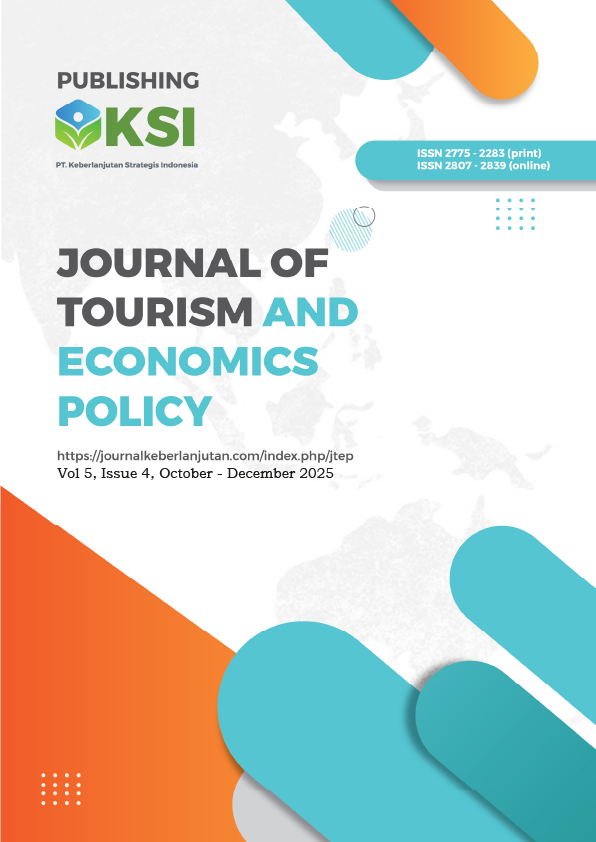Analysis of Digital Payment Implementation in Improving Hotel Operational Efficiency: A Case Study at Hotel X
DOI:
https://doi.org/10.38142/jtep.v5i4.1593Keywords:
Digital Payment, Operational Efficiency, Hotel, Transaction, DigitalizationAbstract
The hotel industry in Bali faces the challenge of continuously innovating to improve operational efficiency along with the increasing number of tourists and the trend of digitalization. One innovation implemented is the use of digital payments to replace cash transactions. This study aims to describe the implementation of digital payments and analyze its contribution to improving operational efficiency at Hotel X Bali, focusing on five main sections: accounts receivable, general cashier, income audit, front office cashier, and restaurant bar cashier. The study used a descriptive qualitative approach with data collection techniques through observation, in-depth interviews, and documentation. Data analysis was conducted based on the theory of efficiency (Syamsi, 2007) which includes six indicators: mind, energy, body, time, space, and objects. The results show that all sections are in the "more efficient" category. The highest score was achieved by the front office cashier at 3.8, while the lowest score of 3.4 was found for accounts receivable and restaurant bar cashier. The implementation of digital payments increases efficiency by accelerating transaction and recording processes, and minimizing errors. Obstacles still found are unstable internet connections, data inconsistencies, and reliance on manual documents. These findings contribute to hotel management in identifying areas that require digital system optimization for better operational efficiency.
References
Azka, V. F., Azhari, T., Sufarhan, A., & Ansori, A. (2024). Efektivitas Pembayaran Digital Keunggulan, Tantangan, dan Solusi. Jurnal Eknomi dan Bisnis Digital, 2(2), 1174–1180.
Nindita, N. N. R. G. A., & Dewi, M. H. U. (2021). Pengaruh Jumlah Kunjungan Wisatawan, Jumlah Hotel dan Upad Minnimum terhadap Penyerapan Tenaga Kerja Sektor Pariwisata. Journal Ekonomi Pembangunan Universitas Udayan, 10(5), 1946–1975.
Noviastuti, N., & Cahyadi, D. A. (2020). Peran Reservasi dalam Meningkatkan Pelayanan terhadap Tamu di Hotel Novotel Lampung. Jurnal Nusantara (Jurnal Ilmiah Pariwisata dan Perhotelan), 3(1), 2597–5323. https://jurnal.akparda.ac.id/31.
Purike, E., Wiwin Kurniasih, I., Wuri Wulandari, F., & Nirwani, A. (2022). Transaksi Digital dan Perkembangan E-Tourism di Indonesia. NAWASENA: Jurnal Ilmiah Pariwisata, 1(2), 12–19. https://doi.org/10.56910/nawasena.v1i2.157.
Salsabila, S. A., & Damanuri, A. (2023). Efektivitas Penggunaan Quick Response Code Indonesian Standard (QRIS) pada UMKM (Food and Beverage) di Kabupaten Ponorogo. Niqosiya: Journal of Economics and Business Research, 3(1). https://doi.org/10.21154/niqosiya.v3i1.1700.
Sugiyono. (2020). Metode Penelitian Pariwisata (Kuantitatif, Kualitatif, Kombinasi, R&D) (N. Yuniati, Ed.; 1st ed).
Syamsi, I. (2007). Efisiensi, Sistem, dan Prosedur Kerja.
Downloads
Published
Issue
Section
License
Copyright (c) 2025 Putri APRILIA, Titien DAMAYANTI, Ni Ketut MARENI

This work is licensed under a Creative Commons Attribution-NonCommercial 4.0 International License.
Creative Commons Attribution-NonCommercial 4.0 International License.





















